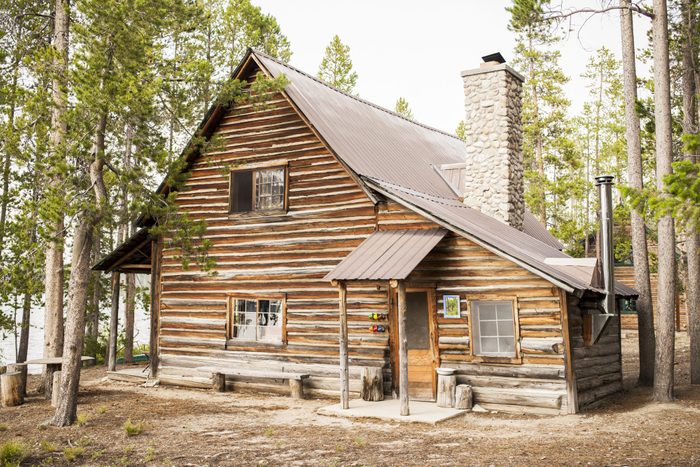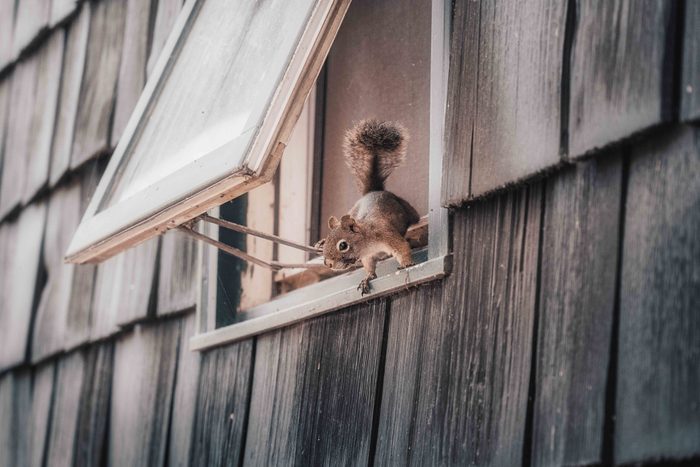
Squirrels
Squirrels love to chew, store food and breed (twice a year, with two to four babies per litter). They’re active all winter and spend summer gathering and storing food.
Look high for entry points with binoculars, and be ready to remove tree limbs that act as ladders to your roofline. Access holes can be surprisingly small. If a squirrel can fit its head through a hole, it can probably fit the rest of its body through as well.
Signs squirrels are living in your cabin
- Sounds of scrambling paws and soft chatter, especially in the early morning.
- Access holes ringed with bite marks.
- Shredded electrical wire insulation. Squirrels sharpen their teeth by chewing, and electrical insulation is a favorite.
- A cache of food, often found in walls.
- Oblong-shaped droppings with rounded ends, light colored, around 1/2-in. long and 1/4-in. in diameter.
- Footprints reveal front paws with four toes, back paws with five.
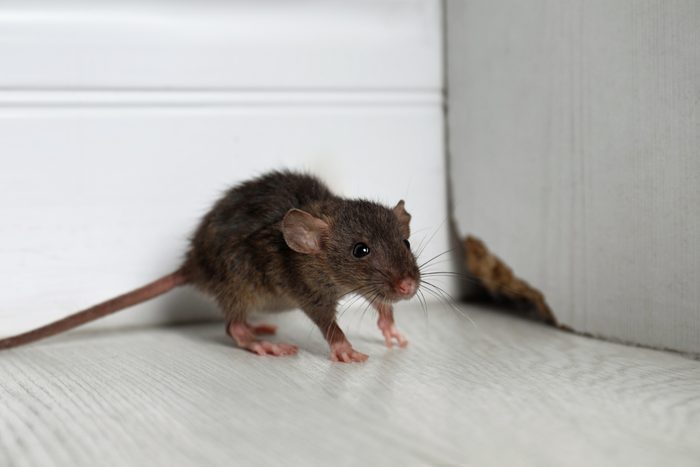
Mice
When you see a mouse, do the math. A female mouse gives birth at six weeks old and has 10 litters a year, a dozen per litter. Mice are incredible gymnasts. They can jump a foot in the air, climb almost any surface and even swim.
If you have mice, you’re not alone. Millions of U.S. households do, too.
Signs mice are living in your cabin
- Sounds of faint scurrying and squeaking, especially at night. Mice, like most rodents, are nocturnal.
- Damaged wire and nesting debris.
- Droppings just about anywhere.
Mice do not defecate in one spot like other rodents. Instead, they poop on the move, leaving up to 75 pellets a day. They’re dark with pointed ends, and tiny, about the size of a small grain of rice. The location of the mouse poop can help you get to the root of an infestation.
Beware: Mice carry nearly 200 human pathogens including Hantavirus and Salmonella. Protect yourself when cleaning up after them.
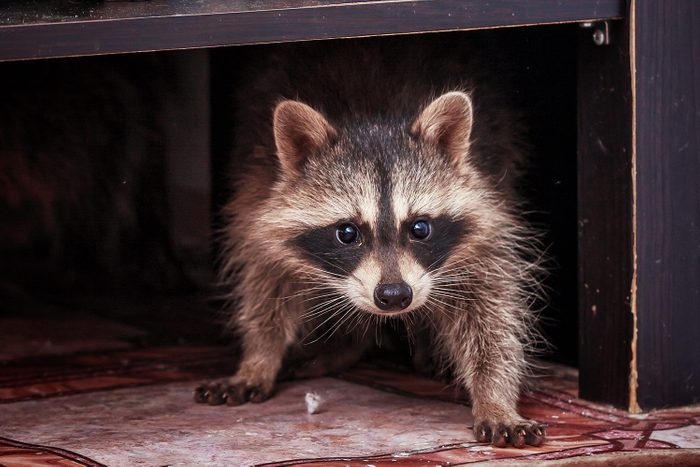
Raccoons
They’re cute and mischievous, but also intelligent and not afraid of a brawl. These are big, strong animals, usually around 20 pounds. Their claws can rip open asphalt shingles and plywood.
Raccoons like warm, dry places, and will enter your attic through eaves, vents and loose soffits. They’ll certainly live in your kitchen if you’re gone for long but generally prefer privacy and access from above. While they live in wooded areas, they’ve thoroughly adapted to living near humans.
Signs raccoons are living in your cabin
- Low growls, shuffling noises and whimpers of offspring. Raccoons give birth from March until June, depending on your location. Raccoons will make a frightful screaming noise if they’re threatened.
- Their footprints resemble human footprints, about four inches long.
- Scratched walls.
- Scat similar to a small dog, about 3/4-in. in diameter. The sides are usually textured, and the tips are often rounded or broken off.
- Toppled garbage cans are a sure sign. Raccoons will make quite a mess and eat all your leftovers.
Beware! If you’re cleaning up after raccoons, wear a mask and gloves. Raccoons carry roundworms, rabies and all sorts of parasites.
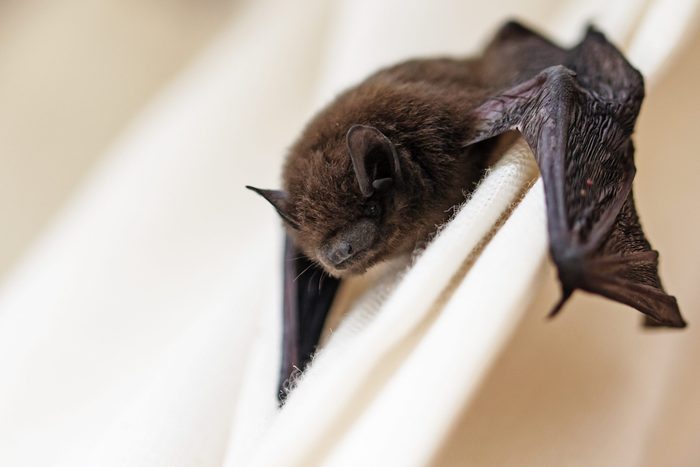
Bats
Bats are active at dusk when they’re leaving to eat. Walk around your cabin, watching, to find the access point. Think like a bat: Even a 1/4-inch gap allows a bat passage. Bats will just as likely enter at the foundation as the roofline.
Also, keep in mind that bats are seasonal, migrating or hibernating in winter. Depending on your latitude, they may only be around in warm months. Pups are born from late April to early June.
Signs bats are living in your cabin
- Bats are relatively quiet. But if one is trapped, you may hear it banging around as it looks for an escape.
- Bats are absolutely nocturnal. At sunrise and sunset, you will see them around your cabin. However, a bat flying in the house is often the first sign of a problem. A dead bat on your property is also a red flag.
- Droppings, called guano, are dark and pebbly, and will accumulate where the bats hang out, so to speak. If it goes on too long, it may soak into the insulation and down into the ceiling.
- Droppings give off a distinct ammonia smell that can be pungent and insistent.
- Their access holes will quickly become stained with a black resin-like material, which can alert you to their route into your home.
Beware: Bats can carry rabies and other diseases, and some bats are protected species.
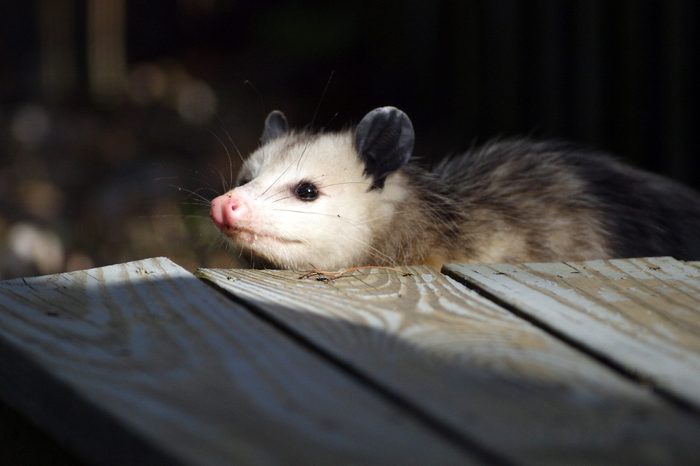
Opposums
These curious creatures are generally docile with poor eyesight. But they’re excellent climbers and don’t mind human proximity. Surprisingly, opossums have opposable thumbs and are really clever. They’re also marsupials with a pouch for carrying their young.
These critters are unmistakable because they’re loud and will come and go at all hours of the day and night.
Signs opossums are living in your cabin
- Listen for hissing, shrieking and a mama possum’s clicking and lip-smacking. They also make a lot of ruckus in their movement. Be aware possums will travel within your cabin. Unlike many others that nest in one place, this creature will roam.
- Damaged soffits and eaves. They love a dark and spacious attic.
- Droppings look much like a house cat’s. It will be a wet mixture of ammonia and feces, and expect a lot. They’re known for their prolific pooping.
- Smell. Opossums are stinky.
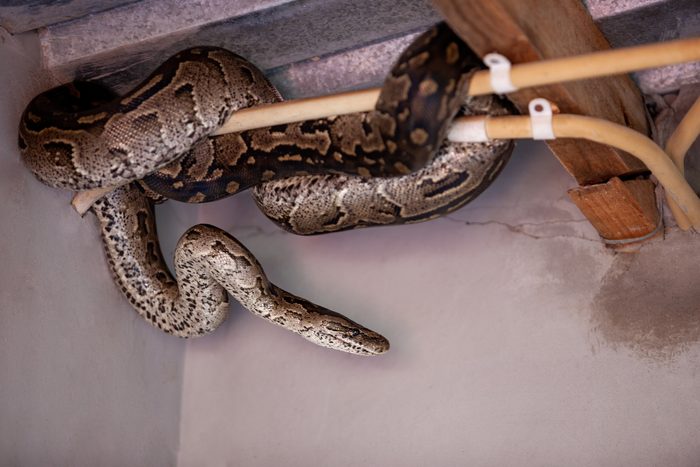
Snakes
Most snakes prefer to be outside, where the sun warms their cold-blooded bodies. A snake inside the cabin suggests good hunting, so you probably have mice, too.
Signs snakes are living in your cabin
- Noises in your walls, ceiling and other hidden places. Some people hear a crinkling paper or sandpaper scratching-like noise from snakes.
- Here’s a surefire DIY test for snakes: Sprinkle a thin layer of flour near areas you suspect may be hiding a snake. Wait 24 hours. If the flour has been slithered on, you’ve got one.
Beware: Snakes can be poisonous, of course. Know your snake before you approach it. And exercise caution when getting snakes away from your cabin.
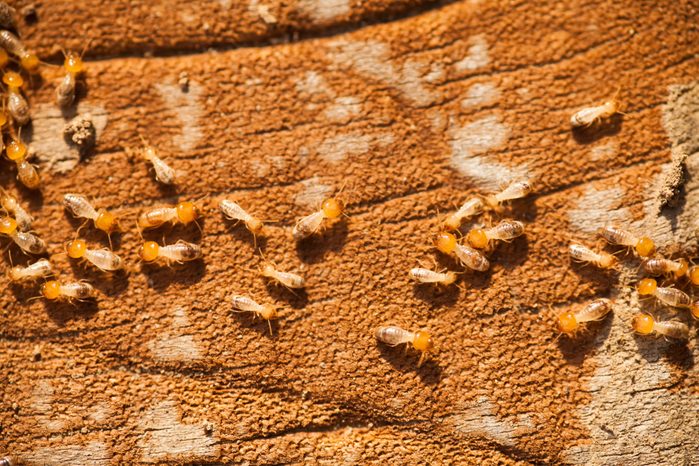
Termites
Termites are attracted to moisture and feed on the cellulose of wood. Because they burrow into the building itself, they can live in your cabin for a long time, causing significant damage before you notice anything amiss. Many cabin owners introduce termites by storing firewood close to or inside the cabin.
Signs termites are living in your cabin
- Damage to your wood surfaces, like peeling paint and crumbling areas.
- In drywall, you’ll see holes the size of pinpoints. Maze-like patterns are a giveaway.
- A pile of sawdust is a red flag. Tap on the wood. If it sounds hollow, you probably have termites.
- Mud tubes on the foundation. These are their highways between colonies and your cabin.
- Piles of wings that may look like fish scales or iridescent flakes.
- Droppings are called frass and resemble salt and pepper.
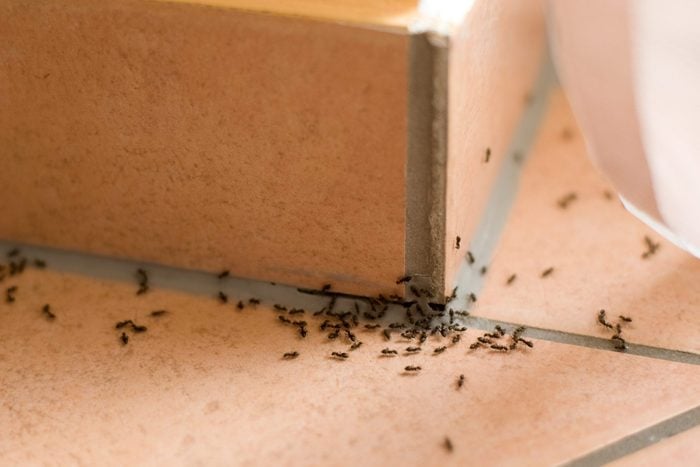
Ants
Ants are social creatures that live in colonies. When you see a few, assume there are more than you can count. And what they want is food and shelter.
Observing the ants can help you figure out what species they are, which determines an elimination plan.
Signs ants are living in your cabin
- If there are a lot of ants in the walls, they may make a rustling noise as they go about their business.
- If you see ants in a line as if following a trail. Ants create a chemical map with pheromones to guide the colony.
- Carpenter ants, large and black, leave a sawdust-like substance at the base of cracks and seams in wood. Tap on the wood and see if it sounds normal. Hollow suggests they’ve already been at work for some time. If it’s muffled, the interior may be full of sawdust.
- Swarmer ants may shed wings near window sills and baseboards.

